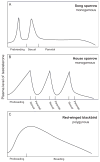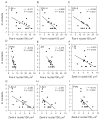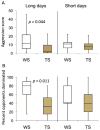Neurogenomic mechanisms of aggression in songbirds
- PMID: 22078478
- PMCID: PMC5461579
- DOI: 10.1016/B978-0-12-380858-5.00002-2
Neurogenomic mechanisms of aggression in songbirds
Abstract
Our understanding of the biological basis of aggression in all vertebrates, including humans, has been built largely upon discoveries first made in birds. A voluminous literature now indicates that hormonal mechanisms are shared between humans and a number of avian species. Research on genetics mechanisms in birds has lagged behind the more typical laboratory species because the necessary tools have been lacking until recently. Over the past 30 years, three major technical advances have propelled forward our understanding of the hormonal, neural, and genetic bases of aggression in birds: (1) the development of assays to measure plasma levels of hormones in free-living individuals, or "field endocrinology"; (2) the immunohistochemical labeling of immediate early gene products to map neural responses to social stimuli; and (3) the sequencing of the zebra finch genome, which makes available a tremendous set of genomic tools for studying gene sequences, expression, and chromosomal structure in species for which we already have large datasets on aggressive behavior. This combination of hormonal, neuroendocrine, and genetic tools has established songbirds as powerful models for understanding the neural basis and evolution of aggression in vertebrates. In this chapter, we discuss the contributions of field endocrinology toward a theoretical framework linking aggression with sex steroids, explore evidence that the neural substrates of aggression are conserved across vertebrate species, and describe a promising new songbird model for studying the molecular genetic mechanisms underlying aggression.
Copyright © 2011 Elsevier Inc. All rights reserved.
Figures







Similar articles
-
Territorial aggression, circulating levels of testosterone, and brain aromatase activity in free-living pied flycatchers.Horm Behav. 2004 Apr;45(4):225-34. doi: 10.1016/j.yhbeh.2003.10.002. Horm Behav. 2004. PMID: 15053938
-
Testosterone and year-round territorial aggression in a tropical bird.Gen Comp Endocrinol. 2000 Jan;117(1):20-33. doi: 10.1006/gcen.1999.7390. Gen Comp Endocrinol. 2000. PMID: 10620421
-
Effect of septal lesions on male song and aggression in the colonial zebra finch (Taeniopygia guttata) and the territorial field sparrow (Spizella pusilla).Behav Brain Res. 1999 May;101(1):167-80. Behav Brain Res. 1999. PMID: 10342406
-
Avoiding the 'costs' of testosterone: ecological bases of hormone-behavior interactions.Brain Behav Evol. 2001 May;57(5):239-51. doi: 10.1159/000047243. Brain Behav Evol. 2001. PMID: 11641561 Review.
-
A continuing saga: the role of testosterone in aggression.Horm Behav. 2005 Sep;48(3):253-5; discussion 256-8. doi: 10.1016/j.yhbeh.2005.05.009. Horm Behav. 2005. PMID: 15996665 Review. No abstract available.
Cited by
-
Experimental competition induces immediate and lasting effects on the neurogenome in free-living female birds.Proc Natl Acad Sci U S A. 2021 Mar 30;118(13):e2016154118. doi: 10.1073/pnas.2016154118. Proc Natl Acad Sci U S A. 2021. PMID: 33753482 Free PMC article.
-
Hormonal regulation of vasotocin receptor mRNA in a seasonally breeding songbird.Horm Behav. 2014 Mar;65(3):254-63. doi: 10.1016/j.yhbeh.2013.11.009. Epub 2013 Dec 11. Horm Behav. 2014. PMID: 24333848 Free PMC article.
-
The effect of chronic and acute stressors, and their interaction, on testes function: an experimental test during testicular recrudescence.J Exp Biol. 2018 Sep 10;221(Pt 17):jeb180869. doi: 10.1242/jeb.180869. J Exp Biol. 2018. PMID: 29997161 Free PMC article.
-
Host defences against avian brood parasitism: an endocrine perspective.Proc Biol Sci. 2018 Sep 5;285(1886):20180980. doi: 10.1098/rspb.2018.0980. Proc Biol Sci. 2018. PMID: 30185646 Free PMC article. Review.
-
Estrogen receptor α polymorphism in a species with alternative behavioral phenotypes.Proc Natl Acad Sci U S A. 2014 Jan 28;111(4):1443-8. doi: 10.1073/pnas.1317165111. Epub 2014 Jan 13. Proc Natl Acad Sci U S A. 2014. PMID: 24474771 Free PMC article.
References
-
- Adkins-Regan E. Hormones and Animal Social Behavior. Princeton University Press; Princeton: 2005.
-
- Allee WC. Analytical studies of group behavior in birds. Wilson Bull. 1936;48:145–151.
-
- Allee WC. Group organization among vertebrates. Science. 1942;95:289–293. - PubMed
-
- Allee WC, Collias NE, Lutherman CZ. Modification of the social order in flocks of hens by the injection of testosterone propionate. Physiol Zool. 1939;12:412–440.
-
- Arcese P, Sogge MK, Marr AB, Patten MA. Song Sparrow (Melospiza melodia) In: Poole A, editor. The Birds of North America Online. Cornell Lab of Ornithology; Ithaca: 2002. - DOI
Publication types
MeSH terms
Substances
Grants and funding
LinkOut - more resources
Full Text Sources
Miscellaneous

